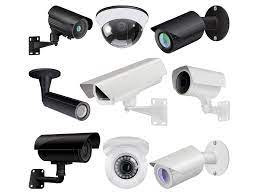All surveillance cameras have a specific function or purpose, which is continuous capturing. This capturing may be pictures, video, or specific measurements, and it is usually stored to be viewed when needed or when something happens and we need to take a look at the recordings. In addition to seeing the cameras capture history directly, this is what is known as surveillance.
In this article, we will focus on taking pictures or videos by cameras dedicated to this purpose. These cameras have many types that differ in their types based on several factors such as environmental factors. The possibility of light and dark is internal and external and is affected by other factors such as sunlight, rain and humidity in addition to technical factors Such as the accuracy of imaging and the ability to store and transfer data.
Types of surveillance cameras
- Rectangular Box Camera
- Dome Camera
- PTZ Camera
- Bullet Camera
- IP Camera
- Day/Night Camera
- Thermal (FLIR) Camera
- Wireless IP Camera
Rectangle Box Camera
Surveillance cameras is named for its shape as it is in the form of a rectangle. T hey are stand-alone cameras and their functions are like other cameras, and they have many designs built on them to withstand environmental factors. They are made of reinforced plastic and metal.
Features of rectangle cameras
It can be used in external or internal environmental housing if the shape is not desired.
Allows lens, cameras, and housing to be customized to suit installation needs.
Offers many lens options including variable focus and fixation.
More solid and withstand environmental factors.
PTZ Camera
PTZ cameras have mechanical controls that allow the operator to move, tilt and zoom the camera from a distance.
PTZ Camera Features
Pan, tilt and zoom feature.
Motion control via joystick or software.
Motion patterns can be turned on automatically or switch to a preset mode.
Focus on areas of movement.
Captures a wide area with the possibility of zoom.
Bullet Camera
It is a combination of camera and lens in a bullet shaped body.
Bullet Camera Features:
Usually includes infrared illuminators.
The closed casing reduces the need for maintenance.
It does not require any separate casing or lens.
Good in low light conditions.
IP Camera
An IP camera transmits a digital signal using Internet Protocol over the network.
Features of IP surveillance cameras
Increased accuracy and scalability
Many have built-in video analysis software.
Better system management than analog cameras.
Resolutions from VGA to 29 megapixels.
Day/Night Camera
Day/Night Security Camera is a camera used indoor and outdoor for environments with low light conditions.
Day/Night Security Camera Features
The infrared filter is raised as the illumination levels decrease.
It handles day and night lighting situations.
Thermal (FLIR) Camera
Thermal cameras use thermal imaging to produce surveillance footage in dark or challenging environments. Heat is used to distinguish things.
Features of the thermal surveillance camera.
Heat sensing is used to distinguish between objects and people.
Detect people and objects in smoke, fog, dust and light fog.
Operates in complete darkness.
Wireless IP Camera
Wireless IP Security Cameras offer ease of installation and eliminate the cost of network connections when you add this camera to your video surveillance system.
Wireless security camera features
- Wi-Fi enabled for easy installation and setup.
- Tilt and rotation options for maximum viewing.
- Motion detection for instant alerts to intruders.
- Ultra-clear images, even in low light conditions.


